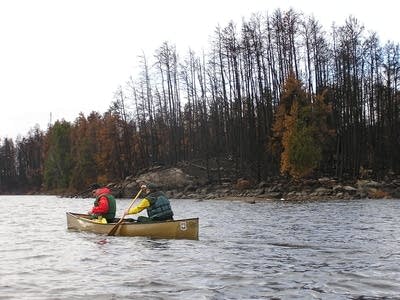In BWCA, new growth blooms even as hot spots still burn

Months after the Pagami Creek Fire started, and more than a month after it ripped through a slice of the most popular area in the Boundary Waters Canoe Area, signs of new life are beginning to show.
Much of the area around the fire remains closed to the public, as fire crews continue to build containment lines around the perimeter of the blaze.
On a calm, cool and gray Wednesday, U.S. Forest Service officials took a small crew of journalists through part of the burn area. Even after a couple miles of paddling through Lake One and Lake Two, this popular part of the Boundary Waters is largely untouched, lush and wild.
On Lake Three, Swaths of shoreline are blackened. Row upon row of dead trees stand like black toothpicks stuck in the scorched earth.
Create a More Connected Minnesota
MPR News is your trusted resource for the news you need. With your support, MPR News brings accessible, courageous journalism and authentic conversation to everyone - free of paywalls and barriers. Your gift makes a difference.
"We had a wind-driven fire that was able to climb up into the crowns of the trees," said Mark Van Every, Kawishiwi District Ranger for the Superior National Forest.
On September 12, the fire raced six miles in one hour with embers jumping three-quarters of a mile in front of it, Van Every said.
"When you have that kind of fire behavior, it doesn't matter how wide you build [a fire line]," he said.
MOST CAMPSITES OK FOR NEXT YEAR
Some campsites looked untouched by the fire, even when the surrounding area was burned. Van Every said the summer's visitors unknowingly helped protect them.
"All the firewood has been collected to rob it of any fuel on the ground," he said.
At other campsites, crews have already cut down snags — burned trees that could topple over at any moment. Carl Skustad, zone wilderness manager for the U.S. Forest Service, acknolwedges it looks a little unwelcoming.
"But it's safe and ready for the public to use again next spring when this area's opened," he said.
Overall, 114 campsites were within the fire area. But Skustad says fewer than a dozen will be closed next year.
A FOREST REBORN
At one of the badly burned campsites at the southernmost shore of Lake Three, charred trees lay crisscrossed on top of each other.
"They look like pixie sticks scattered here throughout the forest," Skugstad said.
But even here, Skustad said, the forest will come back quickly.
"[Charred trees] look like pixie sticks scattered here throughout the forest."
"It's got a lot of nutrients in the soil; it's got a lot of light penetration," he said. "Spring green up will be substantial at this site."
There are already dabs of vivid green on the blackened landscape where grass is poking up through the ash. Nearby, Van Every points out another sign of life renewed. A dead jack pine has toppled over. The species depends on fire because a waxy substance seals the seeds inside the cone.
"Then the heat then melts the wax and causes the cone to pop open," he said.
That allows its seed to scatter over the forest floor.
Van Every said because the soil is still moist in this part of the woods, that means some species' root systems are still intact.
"Things like aspen, blueberries — even seeds that have been down in that soil waiting for the right conditions — will now respond to the sunlight and warming of that soil and sprout in the spring," he said.
That new growth will provide food for species like moose and snowshoe hare, which in turn will help their predators, wolves and lynx.
HOTSPOTS STILL BURN
But the fire's effects aren't all positive. When a fire burns too hot, like it did near Insula Lake, it can take a lot longer for the area to revegetate. Invasive species can also take hold.
The fire is now 91 percent contained, but it's not out — officials expect it to last until snow flies. Along the shoreline of Lake Three, tucked in the moss and roots, fire is still smoldering.
After more than two months and a $22 million battle, the Pagami Creek Fire is still charring the BWCA even as new life emerges from the ashes.


